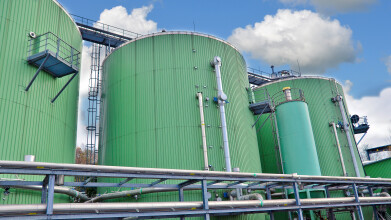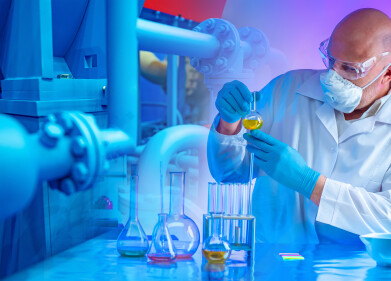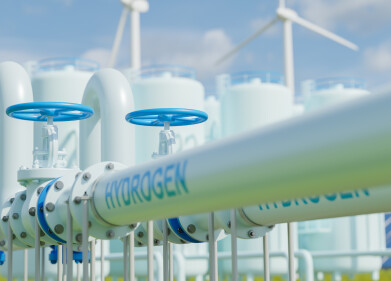Fuel for thought
New technology improves feasibility green ammonia fuel production
Jan 20 2025
Ammonia, a cornerstone of global agriculture, is integral to producing synthetic fertilizers that sustain the world's food supply. However, the environmental toll of the traditional Haber-Bosch process, the century-old method of synthesizing ammonia, is significant—consuming about 2% of global energy and heavily reliant on fossil fuels. A groundbreaking innovation led by researchers at the University at Buffalo could revolutionize this landscape by providing a carbon-free method to produce ammonia using only air, water, and renewable electricity.
Drawing inspiration from natural processes such as lightning, which drives nitrogen fixation in the atmosphere, the team developed a plasma-electrochemical reactor. This reactor, detailed in a study published in the Journal of the American Chemical Society, represents a substantial advance in green ammonia synthesis.
The novel reactor mimics the nitrogen cycle seen in nature. In the atmosphere, the energy from lightning splits nitrogen molecules, creating nitrogen oxides that are then converted into ammonia in the soil by bacteria. The team’s innovation replaces lightning with a plasma reactor and soil bacteria with a copper-palladium catalyst. This system produces ammonia directly from air and water at room temperature, eliminating the need for the high-pressure, high-temperature conditions of the Haber-Bosch process.
“We are rethinking ammonia production in a way that aligns with modern sustainability goals,” explains Chris Li, PhD, the study's corresponding author. “Our process relies solely on renewable electricity and common resources—air and water—making it a zero-carbon solution.”
The plasma-electrochemical reactor functions in two stages. First, the plasma reactor converts humidified air into nitrogen oxide fragments. These are then fed into an electrochemical reactor equipped with a copper-palladium catalyst, which efficiently converts the nitrogen oxides into ammonia.
A key innovation lies in the use of graph theory to optimize the catalytic process. This method enabled the team to map complex reaction pathways and identify bottleneck compounds that hinder ammonia synthesis. By designing a catalyst that stabilizes these intermediates—specifically nitric oxide and amine—the researchers achieved an unprecedented ammonia production rate of 1 gram per day, sustained for over 1,000 hours.
“Plasma energy creates a complex mixture of nitrogen oxides, making selective conversion to ammonia extremely challenging,” says Xiaoli Ge, the study’s first author. “Our graph theory approach allowed us to pinpoint and overcome these challenges, paving the way for efficient and stable ammonia production.”
This breakthrough holds significant promise for the green energy transition, particularly in enabling decentralized ammonia production. Unlike the Haber-Bosch process, which requires massive, centralized facilities, the UB team’s reactor is compact and scalable. Envisioned as a system that could fit into a shipping container and be powered by solar panels, it has the potential to deliver localized ammonia production worldwide, including in regions lacking infrastructure for traditional methods.
“You can imagine our reactors being deployed in underdeveloped regions, providing ammonia on demand for agriculture without the need for large-scale industrial plants,” Li explains. “This could democratize ammonia production, reducing dependence on fossil fuels and the centralized facilities that dominate the market.”
The team is already working to scale up the reactor, with plans for commercialization through a startup and industrial partnerships. The potential impact is enormous: beyond agriculture, green ammonia could play a critical role in energy storage and as a zero-carbon fuel for shipping and other industries.
Ammonia’s energy density and stability make it an attractive candidate for green fuel applications. Unlike hydrogen, which requires cryogenic storage or high-pressure tanks, ammonia can be stored and transported using existing infrastructure. This positions it as a viable alternative to fossil fuels, particularly for industries seeking to decarbonize operations.
The plasma-electrochemical reactor represents a transformative step in ammonia production, aligning with global efforts to reduce carbon emissions and achieve sustainability goals. By combining cutting-edge science with nature’s wisdom, the University at Buffalo team has not only addressed the environmental shortcomings of the Haber-Bosch process but also unlocked new opportunities for green energy applications.
As the world grapples with the dual challenges of feeding a growing population and combating climate change, innovations like this offer a beacon of hope. The ability to produce green ammonia on demand, using nothing more than air, water, and renewable electricity, could redefine the future of sustainable agriculture and energy.
Digital Edition
PIN 25.6 Buyers' Guide
January 2025
Buyers' Guide Directory - Product Listings by Category - Suppliers Listings (A-Z) Articles Analytical Instrumentation - ASTM D7042: The Quantum Leap in Viscosity Testing Technology -...
View all digital editions
Events
Jan 25 2025 San Diego, CA, USA
SPE Hydraulic Fracturing Technology Conference and Exhibition
Feb 04 2025 The Woodlands, TX, USA
Feb 05 2025 Guangzhou, China
Trinidad and Tobago Energy Conference 2025
Feb 10 2025 Point Lisas, Trinidad
Feb 10 2025 Lagos, Nigeria



















